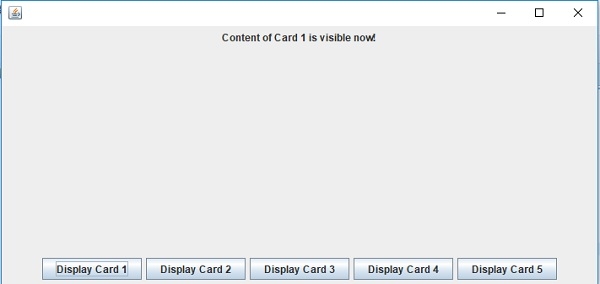
 Data Structure
Data Structure Networking
Networking RDBMS
RDBMS Operating System
Operating System Java
Java MS Excel
MS Excel iOS
iOS HTML
HTML CSS
CSS Android
Android Python
Python C Programming
C Programming C++
C++ C#
C# MongoDB
MongoDB MySQL
MySQL Javascript
Javascript PHP
PHP
- Selected Reading
- UPSC IAS Exams Notes
- Developer's Best Practices
- Questions and Answers
- Effective Resume Writing
- HR Interview Questions
- Computer Glossary
- Who is Who
Java Program to display 5 different cards in a CardLayout
Use CardLayout layout and set it to panel −
JPanel panel = new JPanel(); CardLayout cardLayout = new CardLayout(); panel.setLayout(cardLayout);
In the same way create 5 panels and 5 buttons to display 5 different cards.
The following is an example to display 5 different cards in CardLayout −
Example
package my;
import java.awt.BorderLayout;
import java.awt.CardLayout;
import javax.swing.JButton;
import javax.swing.JFrame;
import javax.swing.JLabel;
import javax.swing.JPanel;
public class SwingDemo {
public static void main(String[] args) {
JFrame frame = new JFrame();
frame.setSize(550, 300);
JPanel panel = new JPanel();
JPanel panel1 = new JPanel();
JPanel panel2 = new JPanel();
JPanel panel3 = new JPanel();
JPanel panel4 = new JPanel();
JPanel panel5 = new JPanel();
JPanel btnPanel = new JPanel();
JLabel label1 = new JLabel("Content of Card 1 is visible now!");
JLabel label2 = new JLabel("Content of Card 2 is visible now!");
JLabel label3 = new JLabel("Content of Card 3 is visible now!");
JLabel label4 = new JLabel("Content of Card 4 is visible now!");
JLabel label5 = new JLabel("Content of Card 5 is visible now!");
JButton btn1 = new JButton("Display Card 1");
JButton btn2 = new JButton("Display Card 2");
JButton btn3 = new JButton("Display Card 3");
JButton btn4 = new JButton("Display Card 4");
JButton btn5 = new JButton("Display Card 5");
CardLayout cardLayout = new CardLayout();
panel.setLayout(cardLayout);
panel1.add(label1);
panel2.add(label2);
panel3.add(label3);
panel4.add(label4);
panel5.add(label5);
panel.add(panel1, "link1");
panel.add(panel2, "link2");
panel.add(panel3, "link3");
panel.add(panel4, "link4");
panel.add(panel5, "link5");
btn1.addActionListener(e -> cardLayout.show(panel, "link1"));
btn2.addActionListener(e -> cardLayout.show(panel, "link2"));
btn3.addActionListener(e -> cardLayout.show(panel, "link3"));
btn4.addActionListener(e -> cardLayout.show(panel, "link4"));
btn5.addActionListener(e -> cardLayout.show(panel, "link5"));
btnPanel.add(btn1);
btnPanel.add(btn2);
btnPanel.add(btn3);
btnPanel.add(btn4);
btnPanel.add(btn5);
frame.add(panel, BorderLayout.NORTH);
frame.add(btnPanel, BorderLayout.SOUTH);
frame.setDefaultCloseOperation(JFrame.EXIT_ON_CLOSE);
frame.setVisible(true);
}
}
The output is as follows. Card 1 is by default visible −
Output

Click on “Display Card 2” to display another card −
Output


Advertisements
